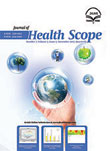فهرست مطالب

Journal of Health Scope
Volume:2 Issue: 3, Autumn 2013
- تاریخ انتشار: 1392/09/08
- تعداد عناوین: 10
-
-
Pages 119-124BackgroundDelayed onset muscle soreness (DOMS) is the sensation of stiffness and pain in the muscles that occurs 24-48 hours after unaccustomed or strenuous exercise..ObjectivesThe aim of this study was to examine and compare the effect of vibration training (VT) on Delayed onset muscle soreness..Materials And MethodsTwenty healthy non-athletic volunteers (Female, age 20-30 years, body mass 23.27 ± 0.82 kg) were randomly assigned to VT (n = 10) and non-VT (n = 10) groups. A vibrator was used to apply 50-30 Hz of vibration on the left quadriceps and calf muscles in the VT group, while no vibration was applied for the non-VT group. Then, both groups ran downhill on a -5° treadmill at a speed of 5-7.5 km/hour (increasing speed). Twenty-four-hours before and after the vibration training, serum creatine kinase levels, pressure pain threshold and the rate of edema were measured..ResultsCompared with the non VT group, the VT group showed a significant decrease in pressure pain threshold at 15 cm of patellar point (P = 0.042) and calf muscle (P = 0.041), there were no significant differences between groups in the pressure pain threshold at 5 cm (P = 0.509) and 10 cm (P = 0.152) points. There was no significant change in the edema rate at the Gastrocnemius muscle (P = 0.420) and midpoint of quadriceps muscle (P = 0.380) in VT and non-VT groups. Despite the increase in creatine kinase enzymes in the two groups, there was no statistically significant difference between the groups (P = 0.173)..ConclusionsThe results showed that using the vibration training can affect delayed onset muscle soreness (DOMS) reduction between non-VT and VT groups. Further studies with larger samples are needed to determine the vibration training positive and negative effects..Keywords: Vibration, Exercise, Creatine Kinase
-
Pages 125-129BackgroundRice is common foodstuffs in Iran. Aflatoxin contamination of rice can be hazardous human health and causes economic problems..ObjectivesDetermination of Aflatoxin levels was investigated on the imported rice which is consumed as the main food in this area..Materials And MethodsTwo hundred samples of imported rice consisting; yellow (100) and white (100) rice were selected randomly. These samples were assessed for Aspergillus infection and the Aflatoxins B, G was detected by high performance liquid chromatography (HPLC) method..ResultsThe results showed, 33% and 47% of yellow and white rice samples had contaminated 0.34 and 0.58 part per billion (ppb) with Aflatoxin B1 respectively. It was observed 13% and 21% following samples had also contaminated 0.06 and 0.08 ppb Aflatoxin B2 respectively. The levels of G1 and G2 Aflatoxins were impossible to identify in these samples..ConclusionsAccording to proposed standards, none of the imported rice sample had not contaminated more than the maximum allowable concentrations of Aflatoxin..Keywords: Oryza Sativa, Food Contamination, Aflatoxin, Iran
-
Pages 130-135Background
Compact fluorescent lamp (CFL) is a developed fluorescent lamp type designed to saving energy. CFLs can cause an increased health risk to humans due to the ultraviolet radiation..
ObjectivesThe current study aimed to assess the ultraviolet radiation emitted from compact fluorescent lamps in highly used Iranian brands..
Materials And MethodsThis experimental study was conducted on 16 CFLs that were manufactured by four Iranian manufacturers including: Pars Khazar, Parmis, Etehad and Nama Noor. The CFLs were marked as 11, 18, 40 and 60 Watt. Measurement was done in 10, 25, 50, 100, 150 and 200 cm in three angles including 0°, 45° and 90° using a calibrated UV-meter. All the CFLs are aged for one hundred hours in the laboratory. The information was analyzed using SPSS-20 and ANOVA test..
ResultsMeasurement of UV showed that UVC emission was not observed at the distance of 10 cm in all of CFLs lamps. UVB irradiance in most of lamps in 10 and 25 cm was more than occupational exposure limits (OEL), but in 50 cm was less than OEL. One way ANOVA indicated that differences between UVB irradiance of four brands of lamps were not significant statistically (P > 0.05). UVA irradiance of all CFLs lamps in 25 cm was less than OEL. One way ANOVA indicated that differences between UVA statistically were not significant (P > 0.05)..
ConclusionsBased on the results of this study, authors recommended that CFLs lamps, due to UV radiation, especially in UVB span, be used at distances greater than 25 cm.Compact Fluorescent Lamp (CFL) is a developed fluorescent lamp type designed for saving energy. CFLs can cause the health risk increase in humans due to the ultraviolet radiation..
Keywords: Ultraviolet Rays, UV Exposure, UVA, UVB, UVC, Fluorescent Lamp -
Pages 136-144BackgroundDyes are one of the most important industrial pollutants, especially in textile industries. Many methods have been proposed in order to remove color from wastewater among which, adsorption is more acceptable due to the ability for its use in the large scale..ObjectivesThe objective of this study was to investigate pumice as an inexpensive adsorbent for removal of Methylene Blue from aqueous solutions..Materials And MethodsIn this work the Modified Pumice Stone has been applied for removal of the Methylene Blue dye from aqueous environments. The effect of pH, contact time, initial concentration and amount of adsorbent were considered. In order to investigate the mechanism of the adsorption process, several kinetic models including pseudo-first order, pseudo-second order and intra-particle diffusion were used. In addition, equilibrium data was fitted on to Langmuir, Freundlich, Temkin and Dubinin-Radushkevich models..ResultsResults showed that the adsorption of the Methylene Blue was enhanced with increasing initial dye concentration, pH and contact time. The optimum pH was 10. The qmax for adsorption of methylene blue dye from the Langmuir model was 15.87 mg/g. Considering the values of R2 (0.999) and χ2, Freundlich isotherm model and pseudo-second order kinetic model had the best fitness..ConclusionsThis study has demonstrated that the modified Pumice stone with HCl can be employed as effective and inexpensive adsorbent for the removal of Methylene Blue from aqueous environments..Keywords: Pumice, Methylene Blue, Adsorption
-
Pages 145-148BackgroundWelding is defined as linking two metals with a local conjunction in sufficient thermal, pressing and metallurgical condition. There are several methods for linking two metals in welding..ObjectivesWelding is one of the professional jobs in Iran, yet there have not been considerable studies on its harmful effects. The current study aimed to compare lung functional tests between welders and non-welders..Patients andMethodsA descriptive-analytical study was done on 110 subjects including: 55 welders (as case group) and 55 non-welders (as control group) in Zahedan, Iran. Samples were selected non-randomly. All spirometric indices were examined in both groups and reported as Mean ± SD and analyzed by appropriate statistical tests by SPSS software..ResultsThe data indicated that all measured spirometric indices decreased significantly (P < 0.01) in welders compared to the control group. Also, reverse relation was observed between welding history and lung functional tests (P < 0.01)..ConclusionsFume inhalation resulted from metal welding can lead to inappropriate changes in lung tissue and respiratory complication which finally cause symptoms as asthma and chronic obstructive pulmonary disease..Keywords: Electricity, Welding, Spirometry, Lung Capacity, Respiratory Function Tests
-
Pages 149-155BackgroundIndustrial effluents the major contaminants of the environment and colored wastewaters from the textile industries are the main sources of environmental pollution..ObjectivesThe present study aimed to determine the appropriate MWCNTs dosage to adsorb RR-198 and identify the thermodynamic parameters such as the free energy (ΔG °), entropy (ΔS °), and enthalpy (ΔH °) changes during adsorption process at various temperatures..Materials And MethodsThe present laboratory research investigated the effect of pH, adsorbent dose, temperature, initial dye concentration, and contact time on the adsorption process of RR-198 by MWCNTS. The values of thermodynamic parameters were determined to establish the adsorption mechanism. Also, the isotherm model has been investigated..ResultsThe RR-198 absorption rates were 33.26 and 222.88 mg/g, respectively for 20, and 200 mg/L dye concentration, at pH of 3, 600 mg/L dose of adsorbent, and 120 minutes time. In addition, the maximum absorption was observed at 600 mg/L dose of MWCNTs. Also, the studied dye absorption isotherm was fitted Freundlich model (R2 = 0.996 at 298K) and, the maximum adsorption capacities calculated by Freundlich model was 169.73 mg/g at 298K. All ΔG ° values were negative. The values of enthalpy (ΔH °) and entropy (ΔS °) were 38.119 KJ/mol, and 134.93 KJ/mol, respectively..ConclusionsThe study results showed that by increasing the initial dye concentration and contact time, the adsorption capacity increased, as well. Moreover, the thermodynamic parameters (ΔH °, ΔG °, and ΔS °) revealed the endothermic sorption of RR-198 onto MWCNTs..Keywords: Adsorption, Textile Industry, Thermodynamics
-
Pages 156-161BackgroundIn many industries, noise is attributed as the most prevalent harmful agent threatening workers'' health. Geographic Information System (GIS) is an applicable surveying tool in civil engineering. But, the use of GIS for noise and hearing loss screening seems to be partly a new approach..ObjectivesThis study aimed to apply GIS in noise and hearing loss screening in the production hall of a publishing industry..Patients andMethodsA cross-sectional study was conducted on 46 employees working in the production hall of a publishing industry in Iran. First, workers'' hearing threshold was examined by Pure-Tone Audiometry (PTA) at 250-8000 Hz frequencies. Then, the production hall area was divided into squares (6 × 6 m2), taking sound pressure levels (SPL) in each square center by a sound level meter (SLM) according to ISO-9612; 2009. Noise and hearing loss maps were drawn, by Arc GIS-9.2, for different areas of the production hall..ResultsNoise measurements revealed that total sound pressure levels (SPL) in the production hall ranged from 72.3to 94.5 dBA. From the total area of production hall, 20% of it was found to be exceeding the threshold limit value (SPL ≥ 85 dBA) on the GIS-prepared noise map. Fisher exact test showed a significant difference between hearing losses (HL ≥ 25 dB) in the danger zone (SPL ≥ 85 dB) and the warning zone (85 > SPL ≥ 65 dB) (P = 0.005). Among the workers, 50% of them were in the danger zone and 8.8% of those who were in warning zone had varying degrees of hearing losses..ConclusionsGIS can play an important role in better noise and hearing loss screening through providing a set of facilities such as: converting point data to area ones, possibility of classification in different domains of prepared area data, generation of reports on map, graphic, and table, etc..Keywords: Noise, Geographic Information System, GIS, Hearing Loss, Publishing Industry
-
Pages 162-167BackgroundDiesel oil hydrocarbons are the most common contaminants of our biological environment. Considering the fact that Iran is one of the major producers of diesel oil products, it greatly contributes to soil and water pollution. Currently, soil and water pollutions caused by diesel oil products leakage, from distribution stations, is one of the major concerns in Iran. Based on the studies performed in this regard, soil and water pollutions have also been reported around the refineries and transmission lines in Iran..ObjectivesThus, the present research aimed to study the effectiveness of using Acinetobacter Radioresistens in removing n-Hexadecane (n-HXD) from polluted waters..Materials And MethodsIn this research, n-HXD (C16H34) was selected as the representative of diesel oil hydrocarbons. Hence, the bacterium Acinetobacter Radioresistens was chosen to remove this compound from the polluted water..ResultsAccording to the results, the total n-HXD removal rates were 57.2, 87.35, and 91.33 in 10, 20, and 30 days, respectively. The initial concentration was 9615 mg/l. The biological (Acinetobacter Radioresistens) removal rates were 35.51, 49.45, and 51.6%, while the non-biological rates were 21.68, 37.9, and 39.73% in 10, 20, and 30 days, respectively..ConclusionsOur results suggested that in the warm weather and salty soil of Iran, normal n-HXD can be removed from the polluted waters through localized bacterial usage, especially Acinetobacter Radioresistens..Keywords: Waste Water, Petroleum Pollution, Hydrocarbons, n, Hexadecane, Acinetobacter


